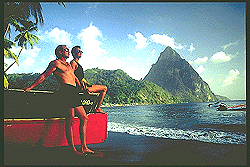
Restaurants & Nightlife | Calendar of Events | Exploring St. Lucia | Natural Attractions | Activities | Weddings | Tourist Offices | St. Lucia Browser's Page | Geographia Home
 St.
Lucia has some of the most overwhelmingly beautiful scenery to be found
anywhere in the world. Amongst the natural beauty of its splendid forests
and soaring peaks are ancient fortresses, gem-like fishing villages,
and gracious town squares, places waiting like buried treasure to be
discovered by newcomers.
St.
Lucia has some of the most overwhelmingly beautiful scenery to be found
anywhere in the world. Amongst the natural beauty of its splendid forests
and soaring peaks are ancient fortresses, gem-like fishing villages,
and gracious town squares, places waiting like buried treasure to be
discovered by newcomers.
St. Lucia's bustling capital is home to several of St. Lucia's historical sights, like the La Toc Battery, and beautiful architecture, including the uniquely decorated Cathedral and the Central Library. There is excellent shopping in the town market and Bagshaws, where the art of silkscreening can be observed.
Morne Fortune (Hill of Good Luck)
Overlooking Castries, this was a key battleground during the period of skirmishes over colonial possession of St. Lucia. The French began constructing a fortress at this strategic outpost in the 17th century, but it was the British who finished it when the French surrendered in 1796.
Marigot Bay
Another vital wartime base, where a British Admiral once ambushed the French by camouflaging his fleet with palm fronds. This picturesque bay is now a yacht haven and one of St. Lucia's most beautiful spots.
Derek Walcott Square
Located in the capital, Castries, a 400-year-old samaan tree shades the Cathedral of the Immaculate Conception, built in 1897.
Anse-le-Ray & Canaries
An afternoon visit to these tiny fishing villages offer an interesting study of one of St. Lucia's main traditions, fishing in dug-out canoes.
Soufriere
Located in the south, it is the oldest town in St. Lucia, established by the French in 1746. Of particular note is its unusual marketplace, decorated with colourful murals and gingerbread trim.
Choiseul
Midway between Soufriere and Vieux Fort on the southwest coast, this village is rich in history, crafts and spectacular views. It is home to a petroglyph carved centuries ago by the island's early inhabitants and Fort Citreon, where only a single cannon remains.
Like Cinderella preparing for the Ball, this fishing village transforms itself every Friday night into a colorful carnival scene, featuring soca and reggae music and a "jump up" (dancing in the streets).
Pigeon Island
Pigeon Island, a 40-acre islet connected by a causeway to St. Lucia's west coast, is a beautiful nature park which reflects a thousand years of history. There are marked trails with a number of historical sites, like the remains of an 18th-century British fort and Fort Rodney, where the Admiral for which it is named spied on the French ships from its strategic viewpoint . The island also has two secluded beaches and is the major venue of St. Lucia's annual Jazz Festival.
The Pigeon Island Museum & Interpretive Centre, displaying the island's history, is housed in a landmark former British officers' mess building, restored to its 1808 elegance. Through interactive audio/visual aids and ancient artifacts, visitors learn about the first Carib Indian settlers and the island's role in the French/British battles during colonization. A highlight is Admiral Rodney's victory in 1782 at the famous "Battle of the Saints." The museum opens daily 9:00am to 5:00pm; admission is EC$5.00 for adults and EC$.50 for children. For information, contact the St. Lucia National Trust (452-5005).
Plantation Tours
Errard Plantation
The drive to Errard, near the village of Dennery, crosses the interior of the island and borders the rain forest. The tour includes an introduction to the various fruit crops, a "cocoa dance," which polishes the beans, and a Creole lunch featuring local fruit juices. For arrangements, call 453-1260.
La Sikwe Historical Sugar Mill & Plantation
Bordering the village of Anse la Raye, the 400-acre estate is set in a beautiful botanical garden. The tour features an onsite museum and cultural theatre with a 40-foot water wheel depicting the sugar-growing years of the 18th century. Tours must be scheduled in advance and can be arranged through any hotel.
Marquis Estate
St. Lucia's largest estate is located just outside of Castries. This working plantation offers insights into the production of St. Lucia's present export crops, banana and copra, as well as the principal crops of previous years, coffee and cocoa. The tour includes a scenic drive along St. Lucia's northeast coast to the countryside, a visit to an old sugar mill, a boat ride on the Marquis river and lunch at the plantation house. Call 452-3762 to arrange a tour.
Morne Coubaril Estate
Overlooking the picturesque town of Soufriere, the tour includes a demonstration of cocoa, copra, and manioc processing, a walk on an original street formerly used by mule carriages, and a visit to a workers' village. To arrange a tour, call 459-7340.